Helldiver Down
Why am I such a fan? I am a member of the Commemorative Air Force (CAF) based in Dallas Texas, USA. I am the current Executive Officer (XO) of the West Texas Wing, one of the early Wings of the CAF. We are the care-takers and operators of the only flying SB2C-5 Helldiver in the World. CAF members pay to be volunteers of the CAF. The only paid positions are at the very top at Headquarters.
Our typical year of operation runs from mid-February through mid-October. Starting with an annual maintenance session where we inspect all the important aspects of the plane from control systems to the most important driving force, the engine. In the past 4 years, we have replaced 4 cylinder heads and pistons on the Wright Cyclone 1,900 hp (1,417 kW) R-2600-20 radial engine. The last time the engine experienced a full rebuild was over 20 years ago. This year we had minor issues any only had to replace two cylinder heads. She was back running at top performance in mid-march. After a few hours of flying the plane, she was cleared for active service.
In mid-June, our Chief Pilot was taking the plane on a rather long journey from Texas to the East coast for re-qualify with the USN Navy Legacy Program. This would guarantee a contract with the USN for the next 5 years. Meaning, if we were contract to an Airshow where a USN Demo team was present, we would be compensated to fly a routine with a current USN Tactical Plane. One of the biggest financial gains we experience in keeping the plane flying. Our main source of funding is from Airshow contracts and individuals purchasing a 45 minute flight experience to sit in the back Gunner/Radio Operator's seat.
On the way to South Carolina, the pilot experience an unusual use of oil. The beast was burning a lot more oil than usual for a radial engine, we are talking gallons of oil per hour. He landed, inspected the plane not noticing anything unusual on the exterior or inside the cowling and contacted the Wing. We had to source replacement oil that would allow him to continue with the mission and determine if we should abort. No abnormal engine responses were experienced so the mission was a go. He successfully obtained oil and completed the check out with an F-18. The following day on the return to base flight, mid-way he experience a severely rough engine and aborted, landing at a nearby airport. The bottom of the fuselage was covered in oil.
It was determined that the plane would not be capable of returning to base. A cylinder was leaking and a plug became fouled causing a pre/post detonation blowing a hole in a cylinder.
The engine now has to be re-built at a cost of $60,000 to $70,000 USD. Luckily, we have most of that in our engine account, but it means our back-up plan and will be expended.
We are in the process of starting a Fund Raising project on the internet. If you are interested in giving to support the World's only flying Helldiver, The Beast. Please message me an email address or find us on Facebook at https://www.facebook.com/pg/sb2chelldiver/posts/?ref=notif. We will be posting more information there.
Here are a few images of the current engine tear down process. I will post more when available.
Regards,
James B
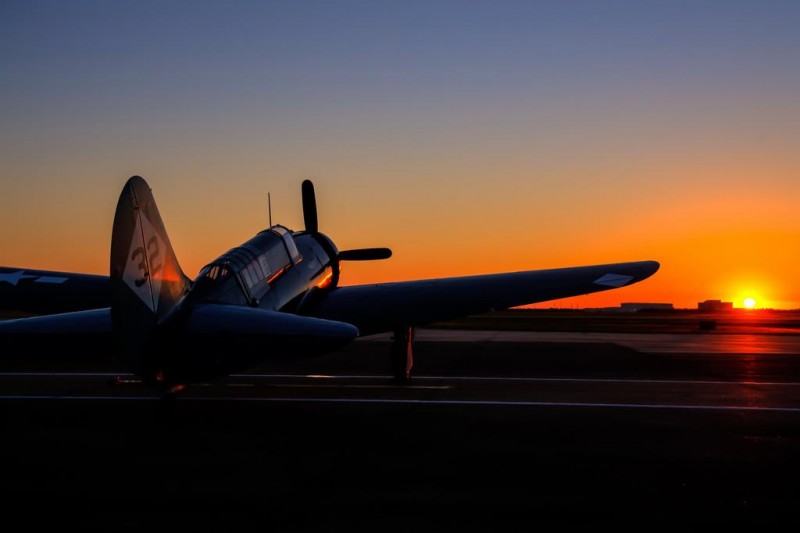
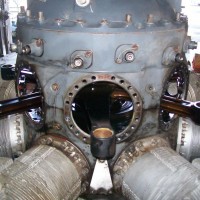
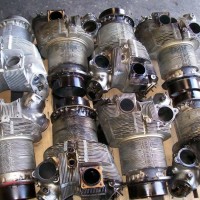

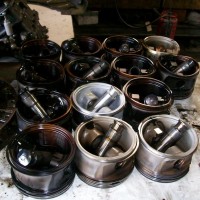
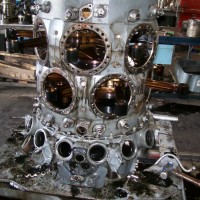
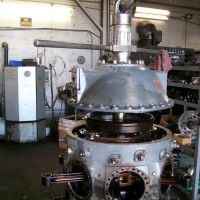

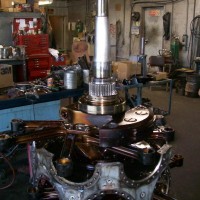
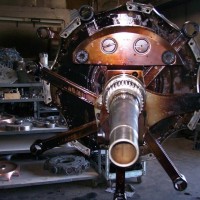
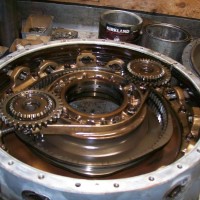
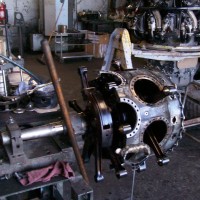
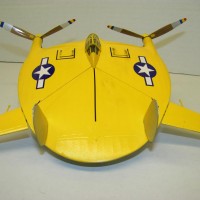

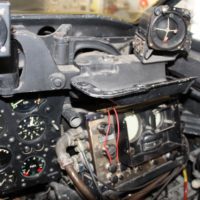
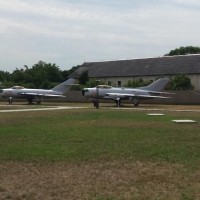
An outstanding set of photos, sir...and looking forward to more - thanks.
Yes, Craig is spot on - outstanding shots - giving us iModelers a great insight into some lesser seen views of the working parts!
These were taken by the shop manager, not me. The lead in Sunrise image is mine, taken 4 years ago in the wee hours of a Sunday morning.
@craigindaytona
@yellow10
And a beauty it is too! Catching the start of the golden hour! Nice warm reflections - love it!
The shop is Anderson Aeromotive in Idaho. They specialize in Pratt & Whitney and Curtiss Wright engines. Here is an interest cut away of a P&W 2800 engine.
http://andersonaeromotive.net/pratt-whitney-r-2800-double-wasp-cutaway/
They have a pretty interesting website with a lot of photos.
Wonderful to see these photos James, and to hear about the work on the Helldiver - please keep us updated!
I love the Helldiver, too. A sentimental favorite.
Hello James! Great report, but I'm sorry to hear about the expensive troubles. @jamesb
My Dad flew Navy during WWII and he flew about every combat plane used during the war, including the SB2C. He also flew rescue missions in OS2Us and his favorite plane, the grand ol' PBY. He was part of what he referred to as the "Kiddy Corps" the nickname they used for the young enlisted pilots. He already had his pilot's license and lied about his age, enlisting on his 17th birthday. Being a strapping young man of 175 lbs. and at 6 feet tall, he got away with the ruse ... until his 18th birthday, when someone in charge found out about the lie and grounded him for 30 days, with loss of 2 ranks (from Petty Officer 1st class to P.O. 3rd class). He served on the USS Independence and others, but the Indy is the only one I know for sure. He enjoyed flying the SOB 2nd class, both as pilot and gunner - whatever was needed at the time. (Same on the SBD, which he said was a real sweetheart to fly.)
Anyway, thanks for bringing this to our attention, James. Good Luck! One of Dad's favorite sayings was; "Any landing you can walk away from is a good one!"
Ship of Theseus: a different perspective. Remember the restored P-38 into the ground with Jeff Ethell; “Kee Bird,” near pristine B-29 burns at the Humbolt Glacier, “Liberty Belle” B-17 burns in Aurora…let’s see how many historic, non-replaceable aircraft we can destroy. We are asked to “restore” these aircraft for the good ol’ boys, and in the process to destroy their historic fabric and integrity (to accommodate tourists in the back seat and meet ever changing FAA regs), and then stand by to watch them burn? Better to donate money to museums that restore static aircraft in accordance with professional museum standards, such as the National Naval Aviation Museum, the Air Force Museum, the Kansas Cosmosphere; where the objective is historic preservation and accuracy vs. good ol’ boy airshow stunt playthings.
@betj
Everyone is entitled to their opinions and beliefs, obviously we don't agree. Personally, I cherish the experience of working on, flying in and general being around Aircraft that my Father and Uncle were involved with over 75 years ago.
Here is a brief history of the Commemorative Air Force (CAF). I must note, none of the planes we operate are owned by ANY individual or 'Good Old Boy'. They are owned by a Museum and we are the people that demonstrate and maintain them.
"It began with a single plane.
Lloyd Nolen and a small group of ex-service pilots from the Rio Grande Valley in Texas pooled their money to purchase a P-51 Mustang in 1957. They formed a loosely defined organization to share the pleasure and expense of maintaining the Mustang.
A short while later, the group added a pair of F8F Bearcats to the P-51 Mustang. At this point, the mission of the CAF became clear: save an example of every aircraft that flew during World War II ~ a mission no one else was undertaking.
What started as a hobby became an urgent mission to preserve history.
By 1960, the group began to search seriously for other World War II aircraft but it quickly became apparent that few remained in flying condition. By the end of the war, America had produced nearly 300,000 aircraft. Just 15 years later, almost all the warbirds were gone.
Decommissioned and stripped of armament and instruments, most of these proud warriors were scrapped or abandoned. No one, not even the Air Force or Navy, was attempting to preserve the historic aircraft that changed the world forever.
On September 6, 1961, the CAF was chartered as a nonprofit Texas corporation in order to restore and preserve World War II-era combat aircraft. By the end of the year, there were nine aircraft in the CAF fleet.
In 1965, the first museum building consisting of 26,000 square feet was completed at old Rebel Field, Mercedes, Texas. The CAF created a new Rebel Field at Harlingen, Texas, when they moved there in 1968, occupying three large buildings. The CAF fleet continued to grow and included medium and heavy bombers such as the B-29, B-25, B-17 and B-24.
The organization was originally known as the Confederate Air Force. Following a membership vote in 2001 and made effective on January 1, 2002, the organization is now called the Commemorative Air Force.
Collecting aircraft for nearly a half a century, the CAF now ranks as one of the largest air forces in the world. Today the CAF has approximately 13,000 members and a fleet of more than 175 aircraft representing more than 60 different types—including planes from several foreign countries and other military conflicts since World War II.
The Headquarters of the CAF is located in Dallas. CAF members live in every state and 28 foreign countries. In 26 states and four foreign countries, our members have joined together and formed units to foster camaraderie and, in many cases, actively support one or more of the classic military aircraft operated by the CAF.
CAF Mission Goals:
"A generation which ignores history has no past and no future" – Robert Heinlein
The CAF was founded to acquire, restore and preserve in flying condition a complete collection of combat aircraft which were flown by all military services of the United States, and selected aircraft of other nations, for the education and enjoyment of present and future generations of Americans.
More than just a collection of airworthy warplanes from the past, the CAF's fleet of historic aircraft, known as the CAF Ghost Squadron, recreate, remind and reinforce the lessons learned from the defining moments in American military aviation history.
CAF Objectives:
The Commemorative Air Force has over 70 units in the United States and other countries.
Through it’s units, the CAF maintains and flies over 170 historical aircraft. The CAF prides itself on it's volunteer members and their mission to protect these rare flying monuments to freedom.
As for statements like "donate money to museums that restore static aircraft in accordance with professional museum standards, such as the National Naval Aviation Museum,...". Great idea. Please do so. I will in turn continue to support the CAF and their Professionals who bring these "Museum" pieces to the public that mostly cannot see these marvelous machines in a Museum on Static Display.
If you feel the need to respond, please do so in a private message and not waste anyone else's time.
You know where to find me.
Well, a couple of things…yup, …can find you here, discuss it here openly, and the readers decide for themselves whether it’s a waste of time; though clearly it remains a waste of money to fund the good ol’ boys and the carnival rides around the patch in their a-historic, shoe-string modified, and routinely crashed/burned playthings…increasingly rare monuments to gob indulgence. AT-6s are not Zeroes and LB-30s are not B-24s. I’ve seen it, coach…having directed three airshows, two of which were Thunderbird airshows, done the ICAS drill, and worked with folks like Tom Thomas and Dave Tallichet, among other warbird owners. I know the drill. The one bright spot in an otherwise dark ‘warbird’ picture is the Collings Foundation. They’re genuine in their efforts, professional in their programming for ‘living history’ museum work, and let’s hope their real B-24 remains safe…but that still doesn’t alter the original point that real museums, in accordance with professional museum standards (such as NASM, Seattle Museum of Flight, Air Force Museum, etc), are going to give modellers something genuine, researched, properly restored and meaningful for their money. Oh, by the way, you’ll be delighted to know that a Helldiver won 1/72d out of the box category at IPMS nationals last week…which as I recall, ...you know…. IPMS…modelling stuff… the real reason for this site?
Bert @bertj,
Fair enough, we will disagree on some things. My choice – Your choice.
Yes, I was aware of the IPMS Nationals and the 1/72 Helldiver.
I agree, AT-6 and other derivatives are not accurate IJN aircraft. But they can make up something similar for flight display, and movies prior to CGI capabilities. I have personally been inside an A6M and there are no similarities with an AT-6.
Here’s a brief history of the Tora group for readers:
“Tora Tora Tora" began in 1972, when six replica Japanese aircraft used in the movie of the same name were donated to the CAF. The Gulf Coast Wing requested assignment of the aircraft and began developing an act for presentation at air shows. The act debuted at the Galveston Air Show on June 25, 1972. By 1977, Tora had gained national exposure. By 1978, Tora began to make international appearances in Canada and Mexico. In 1991, Tora participated extensively in the 50th anniversary year commemorations of Pearl Harbor and in 1992, Tora tackled the challenge of sending two replica Zeros to Alaska to participate in the 50th anniversary commemoration of the raid on Dutch Harbor. Throughout the 90s, Tora has been in demand at air shows throughout the country and in 2000, Tora aircraft and pilots participated in the filming of the Disney movie "Pearl Harbor".”
BTW, we have recently added a Curtiss P-36 "Hawk" also known as the Curtiss Hawk Model 75 to the Tora group. Best known as the predecessor of the Curtiss P-40 Warhawk. Five P-36's were able to take off during the attack on Pearl Harbor and were credited with shooting down two A6M2 Zeros.
Yes, the CAF B-24 is not a “True” B-24. We don’t hide behind that. It is on the website and given as information when it makes appearances. Your reference to the Collings Foundation. Yes they are a fine foundation and their B-24 is one of the most accurate if not the best one operational. I have a lot of friends with the organization and one of their top pilots is a very good friend and also a member of the CAF.
I’m also a supporting member of the Lone Star Flight Museum or LSFM https://www.lonestarflight.org/ located in Houston. Several of the Collings planes based in Houston and the SB2C Helldiver are stored in their air-conditioned Museum on static display when not flying to shows.
More to the point………..I was hesitant in posting the images of the engine rebuild, but decided that it would give a better perspective of the engine’s appearance and be of interest to a few. I have shared some of the past maintenance images privately with a few and have found that there are some in the membership here that have a deep connection with the Helldiver. Members have expressed they have Father’s, Uncles and Grandfathers that have been involved with a version of this plane.
I was not trying to solicit money and probably should have worded it differently. I was attempting to relay the fact that if some having a connection to the plane or those feeling a desire and can find the ability to give, I can direct them to the right place. The Helldiver’s Facebook page has 2,417 more followers than iModeler and has several benefactors that contribute regularly. I am sure that we will replenish the engine fund in a timely manner.
The West Texas Wing is responsible for the funding of the plane, not the CAF. What we raise throughout the year has to pay for the Insurance, fuel and maintenance. It is OUR sole responsibility. Without US………..she won’t fly.
Thank you for your kind response.
3 attached images. Click to enlarge.
Did you take these, they look a tad different on the IPMS site. Great looking model.
Thank you, and all that the CAF does, James.
To put the size of the Engine into perspective, here is a few dimensional characteristics:
Type: 14-cylinder supercharged air-cooled two-row radial engine
Bore: 6 1⁄8 in (155.6 mm)
Stroke: 6 5⁄16 in (160.3 mm)
Displacement: 2,604 in3 (42.7 L)
Other aircraft that were equipped with the same engine were:
Boeing 314 Clipper
Brewster SB2A Buccaneer
Douglas A-20 Havoc
Douglas B-23 Dragon
Grumman F6F Hellcat (XF6F-1 & -2 prototypes only, pre-April 1942)
(Final production models received the 18-cylinder Pratt & Whitney R-2800 Double Wasp)
Grumman TBF Avenger
Lioré et Olivier LeO 451
Martin Baltimore
Martin PBM Mariner (versions prior to Double Wasp-powered PBM-5)
Miles Monitor
North American B-25 Mitchell
Vultee A-31 Vengeance
Bore: 6 1⁄8 in (155.6 mm)
Stroke: 6 5⁄16 in (160.3 mm)
Displacement: 2,604 in3 (42.7 L)
These photos are from a few years ago when we replaced 2 cylinder heads and pistons.
3 attached images. Click to enlarge.
Wow, sorry to hear this.
We had a similar local experience with the SBD when it made a landing several years ago at the Bob Lee airport, which happens to be a shorter grass strip. The pilot did a wonderful job of landing it when the oil pressure dropped. It too split a lower cylinder.
I appreciate these flying planes, and understand the amount of work that goes into them simply to keep them in the air.
Museums are great too. It's good to hear from both sides of the coin. I understand the concerns.
But there's nothing that compares to the sound of a R-2800 on start up... (except for maybe a RR Merlin or DB-605). The cloud of smoke, the sounds, the smells, the rumble in the air, the excitement. Words can't really describe this. It's something you have to experience first hand to appreciate.
OK maybe I'm just an airplane nerd...
It takes you back to a time not so long ago.
Thanks gentlemen for keeping this friendly and civil.
James,
These are some amazing photographs. Thanks for sharing, and if you don't mind, please keep us updated on the status.
One more hydraulic fitting than a B-17, and 3 less engines...
You got it Louis @lgardner, I post as they come in. Hopefully when she's back and in transport I'll drive out to Mississippi, document the re-installation and return to flight.
The day has finally come, the Crowdrise Fund Drive has started. For those of you interested, here is the link:
https://www.crowdrise.com/o/en/campaign/helldiver-engine?fbclid=IwAR22LMvSMg5phJUNjlDgjleczNZtIKCQTzHxxGFeatRN-OzJmEui2HsIRI0
The engine is just about to be installed after a very lengthy rebuild process and a small sum close to $62,000 USD. We've actually had her back for a few months, but ran into a few more things to fix/replace. The engine is currently with the plane in Mississippi where it was forced to ground from the original problem.
Here are a few images prior to mounting.
Gentlemen, I posted these photos a few days ago and fear it went unnoticed due to the age of the original posting. I received an update from our Operations Officer last night. The Engine installation is at 90% and hopefully next weekend they will start run up, fine tuning and ground taxi operations in preparation for RTF. She will be in the air by the end of the month, if all goes well.
Regard,
James B
@lgardner, @craigindaytona, @yellow10, @davem, @davidathomas, @iageezer
3 attached images. Click to enlarge.